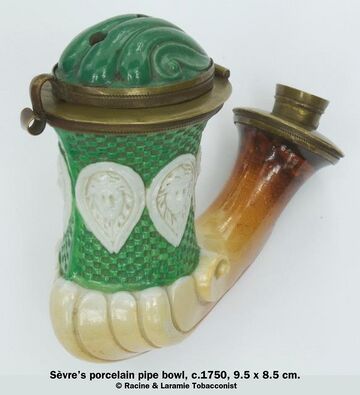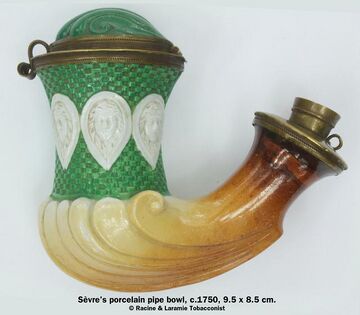Sèvres
The following submission is courtesy of Racine & Laramie Tobacconist
On the decline after 1756 of Meissen Porcelain production from its supreme position as the arbiter of European decorative fashion, Sèvres became the leading porcelain factory in Europe. Louis XV of France had been an early investor in the fledgling ceramic enterprise and became its sole owner in 1759. Perhaps the major factor contributing to its success was the patronage of Louis XV’s mistress Madame de Pompadour. The Chinese had been making hard-paste porcelain for 1000 years before the Europeans.
According to historical records the production of soft-paste porcelain objects started at Vincennes (later the Manufacture Royal de Sèvres) in 1740. The factory was enlarged and moved to Sèvres in 1756 and bought the secret of hard-paste porcelain in 1761. Under its royal charter Sèvres had the exclusive right to manufacture polychromed porcelain in the stye of Meissen. Organizationally the factory engaged a staff of craftsmen each specializing in a separate function. A single artisan did not create a piece from start to finish. A Parisian antique pipe specialist is of the opinion that by the end of the 18th century Sèvres pipe head production had not exceed 300 pieces.
Early porcelain pieces frequently had no factory mark. This makes it almost impossible to distinguish an eighteenth century French-made porcelain bowl from one produced in Germany. But, because the shape of the pipe illustrated here is similar to the “a pans”, Sèvres pipe, bowl shape Ben Rapaport and Sarunas Peckus are confident that this bowl is eighteenth-century French Sèvres.[1]
Remaining traces of its gold plating are visible on the brass stem fitting. The coloration on the base and shank is simulating a colored meerschaum pipe. The conchiform base and cap reflect Rococo influence while the medusa shields dramatically contrast with the basketweave background. Notice the delicate reeding on the cap’s metal frame. There is no maker’s mark.
Gallery
- French Sèvres porcelain pipe c.1750, courtesy Racine & Laramie Tobacconist
References
- ↑ Dr. Sarunas (Sharkey) Peckus and Ben Rapaport, The European Porcelain Tobacco Pipe, 2014 Schiffer Publishing Ltd., Atglen PA.

